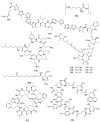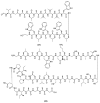Antimicrobial Bacillus: Metabolites and Their Mode of Action
- PMID: 35052965
- PMCID: PMC8772736
- DOI: 10.3390/antibiotics11010088
Antimicrobial Bacillus: Metabolites and Their Mode of Action
Abstract
The agricultural industry utilizes antibiotic growth promoters to promote livestock growth and health. However, the World Health Organization has raised concerns over the ongoing spread of antibiotic resistance transmission in the populace, leading to its subsequent ban in several countries, especially in the European Union. These restrictions have translated into an increase in pathogenic outbreaks in the agricultural industry, highlighting the need for an economically viable, non-toxic, and renewable alternative to antibiotics in livestock. Probiotics inhibit pathogen growth, promote a beneficial microbiota, regulate the immune response of its host, enhance feed conversion to nutrients, and form biofilms that block further infection. Commonly used lactic acid bacteria probiotics are vulnerable to the harsh conditions of the upper gastrointestinal system, leading to novel research using spore-forming bacteria from the genus Bacillus. However, the exact mechanisms behind Bacillus probiotics remain unexplored. This review tackles this issue, by reporting antimicrobial compounds produced from Bacillus strains, their proposed mechanisms of action, and any gaps in the mechanism studies of these compounds. Lastly, this paper explores omics approaches to clarify the mechanisms behind Bacillus probiotics.
Keywords: Bacillus; animal feed; antimicrobials; omics; probiotic.
Conflict of interest statement
The authors declare no conflict of interest.
Figures












Similar articles
-
Bacillus probiotics: an alternative to antibiotics for livestock production.J Appl Microbiol. 2018 Jun;124(6):1334-1346. doi: 10.1111/jam.13690. Epub 2018 Feb 8. J Appl Microbiol. 2018. PMID: 29316021 Review.
-
Antimicrobial Properties of Bacillus Probiotics as Animal Growth Promoters.Antibiotics (Basel). 2023 Feb 17;12(2):407. doi: 10.3390/antibiotics12020407. Antibiotics (Basel). 2023. PMID: 36830317 Free PMC article.
-
Bacillus spp. as direct-fed microbial antibiotic alternatives to enhance growth, immunity, and gut health in poultry.Avian Pathol. 2018 Aug;47(4):339-351. doi: 10.1080/03079457.2018.1464117. Epub 2018 May 2. Avian Pathol. 2018. PMID: 29635926 Review.
-
Effects of the Probiotic Activity of Bacillus subtilis DSM 29784 in Cultures and Feeding Stuff.J Agric Food Chem. 2021 Sep 29;69(38):11272-11281. doi: 10.1021/acs.jafc.1c04811. Epub 2021 Sep 21. J Agric Food Chem. 2021. PMID: 34546731
-
Multi-Omics Characterization of Host-Derived Bacillus spp. Probiotics for Improved Growth Performance in Poultry.Front Microbiol. 2021 Oct 20;12:747845. doi: 10.3389/fmicb.2021.747845. eCollection 2021. Front Microbiol. 2021. PMID: 34745051 Free PMC article.
Cited by
-
Antimicrobial Natural Products.Antibiotics (Basel). 2022 Dec 7;11(12):1765. doi: 10.3390/antibiotics11121765. Antibiotics (Basel). 2022. PMID: 36551421 Free PMC article.
-
The Probiotic Bacillus subtilis MB40 Improves Immunity in a Porcine Model of Listeriosis.Microorganisms. 2023 Aug 18;11(8):2110. doi: 10.3390/microorganisms11082110. Microorganisms. 2023. PMID: 37630670 Free PMC article.
-
Antibiotic profiling of wild-type bacilli led to the discovery of new lanthipeptide subtilin-producing Bacillus spizizenii strains whose 16S rDNA sequences differ from the B. spizizenii typing strain.Int Microbiol. 2022 Nov;25(4):839-850. doi: 10.1007/s10123-022-00266-5. Epub 2022 Jul 28. Int Microbiol. 2022. PMID: 35902452 Free PMC article.
-
His-Ala-Phe-Lys peptide from Burkholderia arboris possesses antifungal activity.Front Microbiol. 2022 Dec 6;13:1071530. doi: 10.3389/fmicb.2022.1071530. eCollection 2022. Front Microbiol. 2022. PMID: 36560956 Free PMC article.
-
Antimicrobial Activity of Bacillus amyloliquefaciens BS4 against Gram-Negative Pathogenic Bacteria.Antibiotics (Basel). 2024 Mar 28;13(4):304. doi: 10.3390/antibiotics13040304. Antibiotics (Basel). 2024. PMID: 38666980 Free PMC article.
References
-
- Hill C., Guarner F., Reid G., Gibson G.R., Merenstein D.J., Pot B., Morelli L., Canani R.B., Flint H.J., Salminen S., et al. The International Scientific Association for Probiotics and Prebiotics consensus statement on the scope and appropriate use of the term probiotic. Nat. Rev. Gastroenterol. Hepatol. 2014;11:506–514. doi: 10.1038/nrgastro.2014.66. - DOI - PubMed
-
- Liu P., Zhao J., Guo P., Lu W., Geng Z., Levesque C.L., Johnston L.J., Wang C., Liu L., Zhang J., et al. Dietary Corn Bran Fermented by Bacillus subtilis MA139 Decreased Gut Cellulolytic Bacteria and Microbiota Diversity in Finishing Pigs. Front. Cell. Infect. Microbiol. 2017;7:526. doi: 10.3389/fcimb.2017.00526. - DOI - PMC - PubMed
Publication types
LinkOut - more resources
Full Text Sources

